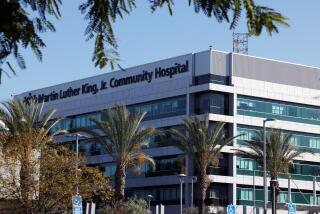Board Votes for Upgrading Neonatal Unit : Medicine: More beds will be added to intensive care area at King/Drew Medical Center. The action comes in response to critical state audit.
- Share via
Faced with increasing numbers of sick newborn infants at Martin Luther King Jr./Drew Medical Center in Watts, the Los Angeles County Board of Supervisors agreed Tuesday to expand and improve the hospital’s neonatal intensive care unit.
The supervisors voted unanimously to add 15 beds to the unit and to an intermediate care area, increasing the size of the wing to 44 beds, instead of proceeding with an earlier plan to enlarge the rest of the hospital by 33 beds.
They said the change is in response to criticism of the hospital’s newborn area by the state Department of Health Services.
Doctors and administrators at the hospital said more neonatal beds are urgently needed to handle the influx of premature babies born suffering from drug addiction and AIDS and from the life-threatening problems triggered by inadequate prenatal care.
“The neonatal unit here has not been large enough to adequately accommodate all of the babies that are delivered here, let alone being able to respond to babies who need . . . to be transported into a facility like this,” said Dr. Ezra Davidson, chairman of the hospital’s obstetrics and gynecology department.
Of about 9,000 babies born at Martin Luther King annually, 500 end up in the neonatal intensive care unit where they can be hooked up to ventilators, monitors and feeding tubes, said Dr. William Taeusch, director of the neonatology division. A baby’s stay can range from days to months, he said.
A study done by Davidson showed that at least 28% of the mothers who give birth at the hospital have received no prenatal care.
The money for the expansion--about $700,000--has been set aside, according to the county’s chief administrative office, although it was originally intended to pay for the adult patient beds. Priorities changed after a state investigation earlier this year targeted deficiencies in the neonatal unit, according to hospital and county administrators.
Jacqueline Lincer, district administrator for the state Health Department’s Licensing and Certification Program, said the hospital had moved too many beds into the intensive care unit.
“They do remarkable things there, but the regulations require that they have a certain amount of space for each bed and they don’t have it,” Lincer said.
Usually, deficiencies cited by the state must be corrected within 30 days, Lincer said, but an exception was made in this case because of the need for construction.
“They’re going to take one whole floor and do it right,” she said. “We’re very pleased that they’re following through with it.”
Under the plan approved by supervisors, the wing’s various services will be grouped in one area. Taeusch said he was optimistic that the expansion of the wing and its consolidation would help in attracting and retaining nurses and residents. He said moving the whole unit also would alleviate crowding in wings for healthy babies.
More to Read
Sign up for Essential California
The most important California stories and recommendations in your inbox every morning.
You may occasionally receive promotional content from the Los Angeles Times.













